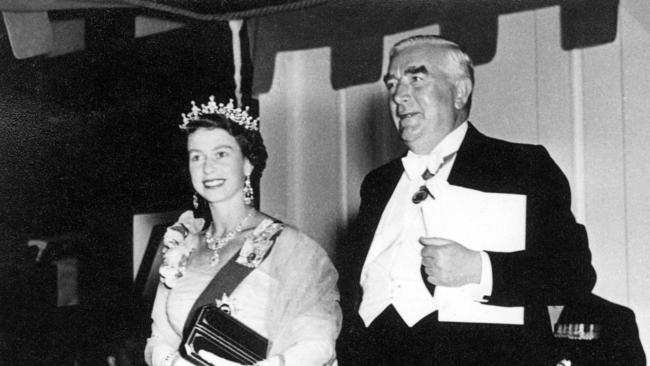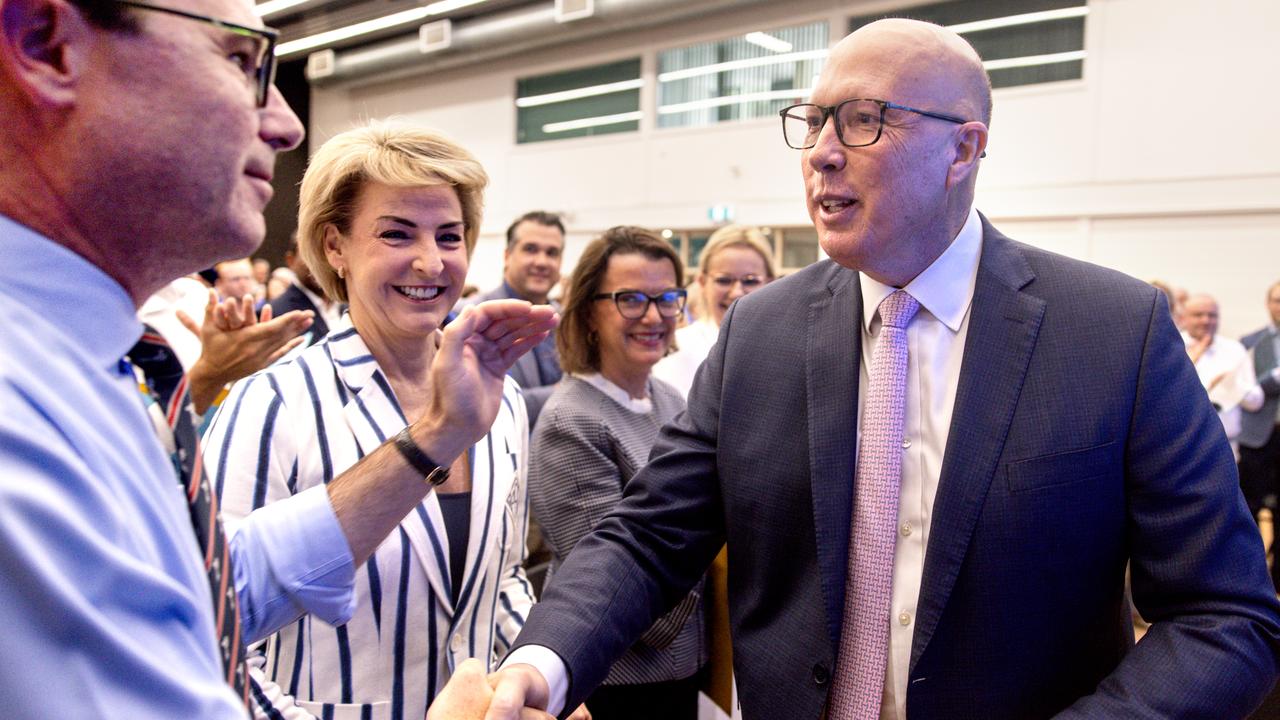Australian prime ministers have long been welcomed at Buckingham Palace
Even the most republican of Australian leaders found a warm welcome when meeting an always well-informed Queen Elizabeth.

At a gala reception at Parliament House in 1963, Sir Robert Menzies glanced at the Queen and quoted the poet, Thomas Ford: “I did but see her passing by, and yet I love her till I die.”
The Queen was visibly discomfited and Menzies, the master politician, had let his emotions carry him away. The Queen raised her eyebrows, gulped and blushed. Menzies’ fawning over the young Queen became etched into historical memory.
Sir William Heseltine, who worked as Menzies’ private secretary (1955-59) and the Queen’s private secretary (1986-90), said the monarch was uncomfortable and that the Prime Minister had made an uncharacteristic error.
“It was the one time that he had really misjudged his audience and I thought the Queen was feeling a bit embarrassed about it too,” he told me. Heseltine made the same point in his 1989 Menzies Lecture. He showed the Queen the lecture before he delivered it, and she raised no objections.
Queen Elizabeth succeeded her father, George VI, in 1952. She reigned during the terms of more than a dozen British prime ministers and 16 Australian prime ministers, not to mention many other Commonwealth leaders.
If Menzies’ laid his respect on with a trowel, the same cannot be said for one of his successors. In 1970, Sir John Gorton hosted the royal entourage during the Queen’s third tour of Australia. Gorton had met the Queen in London a year earlier and felt they had a rapport.
To mark the bicentenary of James Cook’s arrival in Australia, Gorton joined the Queen aboard the royal yacht, Britannia, to view a re-enactment of the Endeavour landing at Cooktown, in Queensland. Gorton also enjoyed a few days relaxation on the yacht with the royal party.
Near a small island on the Great Barrier Reef, as the royal party prepared to go ashore for a picnic and swim, the larrikin Gorton did what Menzies never dreamt of doing.
“It wasn’t long before all the members of the party that had swimsuits were in the water and those that didn’t have swimsuits found themselves being thrown into the water,” Heseltine recalled.
“The only person that hadn’t been in the water was the Queen, and Gorton started looking at her with a suggestion of ‘do we throw her in?’. That’s when, of course, he misjudged the situation because that was not going to happen.” This was made clear to Gorton in unmistakeable terms.
Of all the prime ministers who served during Queen Elizabeth II’s reign, her closest relationship was with Menzies, whom she had met during his first stint as prime minister on a visit to London during World War II. The Queen conferred a personal knighthood on Menzies — the Order of the Thistle — in 1963. She also appointed him Constable of Dover Castle and Warden of the Cinque Ports in 1965.
Menzies hosted the Queen during her first tour of Australia in 1954. “He had that antipodean flair for striking the right note,” recalled Heseltine. “He was not unduly deferential but respectful and friendly.” Whereas Winston Churchill displayed “old-fashioned chivalry”, Menzies “talked seriously” to her.
Whether at Buckingham Palace or Balmoral, at a Commonwealth Heads of Government Meeting, or in Sydney, Melbourne or Canberra, the relationship between the Queen and her prime ministers has been guided by strict protocols and shaped by personal rapport.
Harold Holt attended the Queen’s coronation and had several audiences with her at Buckingham Palace, but could not replicate the closeness she enjoyed with Menzies. Billy McMahon had an audience with the Queen at Buckingham Palace in 1971 but it was nothing more than a formality.
When the Queen’s representative governor-general Sir John Kerr dismissed Gough Whitlam in 1975, the news reached Buckingham Palace by phone in the early hours of the morning.
Heseltine, who was then the Queen’s assistant private secretary, took a phone call from David Smith, the governor-general’s official secretary, about 2am. It came as a complete surprise.
“(Kerr) was very scrupulous about keeping us informed as to what was going on in Australia at the time,” Heseltine recalled, “but he never gave us any clue he was about to dismiss the prime minister.”
Kerr, in his vice-regal correspondence made public in 2020, had outlined various options for resolving the constitutional crisis, including dismissal. The idea of dismissal, discounted by Whitlam, was advocated by the opposition and in newspaper editorials. But there is no documentary or testimonial evidence the Queen personally authorised the dismissal or knew about Kerr’s decisive intervention in advance.
It fell to Heseltine and Sir Martin Charteris, the Queen’s private secretary, to tell her the news from Australia about 8am. The Queen was just as surprised as they were. Heseltine and Charteris thought Kerr acted too hastily and later became concerned that he had damaged the monarchy.
“Given the way in which Kerr behaved after it, with increasingly drunken appearances at official events, everybody was extremely relieved when he indicated he was going to go,” said Heseltine. Malcolm Fraser helped push Kerr to an early retirement in 1977. Whitlam later apologised to the Queen for recommending Kerr as her governor-general.
Whitlam always got on well with the Queen and hosted her on tours to Australia in 1973 and 1974. There was “a mutual affection” between them, recalled Heseltine. The Whitlam government amended her title with the Royal Title and Styles Act 1973, abolished imperial honours and appeals to the Privy Council, and replaced God Save the Queen as the national anthem.
The relationship was sealed at the Queen’s rowdy 47th birthday dinner at Windsor Castle in 1973. Gough and Margaret Whitlam, who were staying overnight, presented the Queen with a sheepskin floor rug. When it was unveiled, amid much wine having been drunk, the Queen and Princess Margaret sat suggestively upon it.
Charteris was stunned. “She wrapped Gough Whitlam round her little finger, knocked him sideways,” he told a journalist years later. “She sat on that rug in front of him, stroked it and said how lovely it was. It was an arrant use of sexuality. I was absolutely flabbergasted.”
Fraser was rather more formal in his dealings with the Queen, as she was with him. Fraser hosted a three-week royal tour in 1977 to mark the silver jubilee and met with the Queen on return visits in 1980, 1981 and 1982. The Fraser government reinstated God Save the Queen for royal and vice-regal occasions. Fraser, like John Howard, preferred Waltzing Matilda as the national anthem.
Heseltine recalled that Bob Hawke had a relaxed relationship with the Queen and they shared “a common interest in horse racing”. Following the military coup in Fiji in 1987, Hawke urged the Queen to recognise that the monarchy was no longer in existence there. This counsel was adopted despite the opposition of British prime minister Margaret Thatcher.
When Paul Keating walked into the Victoria and Albert Room at Balmoral Castle in 1993, the Queen came face-to-face with her most republican of prime ministers. Keating recalled that he was there on “an unpleasant errand” to tell her that it was the policy of his government for Australia to become a republic.
Sir Robert Fellowes, the Queen’s private secretary (1990-99), said she enjoyed Keating’s company and did not disapprove of his republicanism. “The Queen and Prince Philip’s view has always been that it is the business of the people in the realm to decide whether they will or will not wish to continue with the monarchical link,” he told me.
Earlier, in 1992, Keating had sparked outrage during a reception at Parliament House when he put his hand on the Queen’s back and gently ushered her to meet guests, including Dame Pattie Menzies. The British tabloids labelled Keating “The Lizard of Oz” and demanded “Hands Orf, Cobber”.
The Queen was staying at Government House and felt impelled to tell governor-general Bill Hayden that she had not been aware of Keating’s guiding hand. “She said she had absolutely no complaint whatsoever about Keating’s conduct,” Hayden told me.
Howard met the Queen many times during his near-12 years as prime minister. The staunch monarchist first met her as opposition leader at the opening of Parliament House in 1988, where he made the best of the speeches that day.
Howard presided over the republic referendum in 1999 and liaised with the Queen to prepare her responses for whatever the vote was. He also worked closely with her on the suspension of Zimbabwe from the Commonwealth in 2002. The Queen awarded Howard the prestigious Order of Merit in 2012.
Kevin Rudd, like Keating, declined to swear the oath to the Queen on becoming prime minister. Prior to meeting the Queen at Windsor Castle in 2008, Rudd sparked controversy by saying he welcomed an acceleration of the republic debate. He was also criticised for not bowing when greeted by her. There was a slight bend, apparently, when he met her at Buckingham Palace a year later.
Julia Gillard found herself in similar hot water when she failed to curtsy when the Queen arrived in Canberra in 2011. Later, at Government House, Gillard chose to bow when the monarch arrived. Gillard, also a republican, nevertheless had a respectful relationship with the Queen and agreed to her request that Prince Charles succeed her as head of the Commonwealth.
When Tony Abbott became prime minister in 2013, he had a painting of the Queen put up in his office. Soon portraits of the monarch started reappearing in government departments. Abbott was the most monarchist of prime ministers since Menzies.
But he blundered by reintroducing knights and dames into the Order of Australia in 2014. The following year, Prince Philip became an Australian knight. Abbott later said the Queen had indicated Philip would welcome the honour, seemingly shifting the blame towards London.
The contrast with Malcolm Turnbull, who first met the Queen at a Commonwealth Heads of Government Meeting in Malta in 2015, could not be greater. Turnbull, Australia’s pre-eminent republican, led the campaign to sever ties with the monarchy at the 1999 referendum.
When Turnbull had an audience with the Queen at Buckingham Palace in 2017, he conceded never imagining that he would meet the Queen as prime minister. He praised her service, dignity and wisdom, and declared himself to be both a republican and an “Elizabethan”.
Turnbull put his republican ambitions on ice while prime minister and argued that the Queen’s death was the time to revive the push for an Australian republic – perhaps starting with a postal plebiscite offering voters a choice between two republican models. That pledge is now up in lights.
Scott Morrison, a devoted monarchist, bowed several times when he first met the Queen at Buckingham Palace in 2019. Morrison had an audience with the then 95-year-old Queen at Windsor Castle in 2021 and told her she had been “quite the hit” during her appearance at the recent G7 summit in Cornwall.
When Anthony Albanese was sworn in as prime minister in 2022, he declined to swear an oath to the Queen and instead affirmed that he would “serve the Commonwealth of Australia, her land and her people”. He promised to pursue an Australian republic but implementing the Uluru Statement from the Heart is his priority for constitutional change.
Every Australian prime minister since 1952 has, like most Australians, been awed by Queen Elizabeth II’s steady reign, dedication to her duty and the transformation of the monarchy into a new age. Whether monarchists or republicans, Australian prime ministers have, for the most part, served her with deep respect and admiration.



